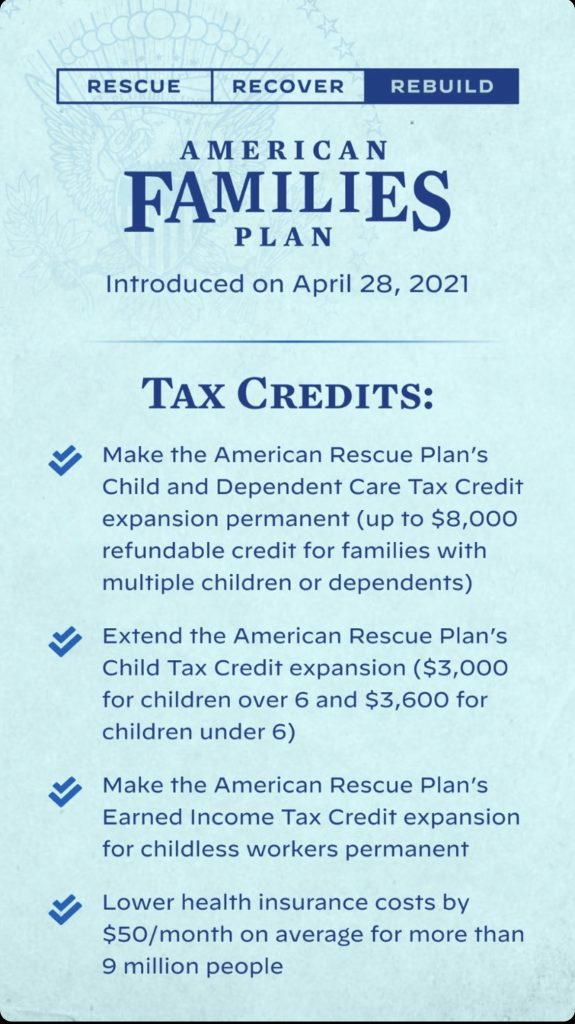Watching President Biden describe some of the details of his American Families Plan this week — well, it’s made me emotional. It’s so much of what we’ve hoped for. And frankly, so much of what our own parents and even grandparents have hoped for.
This is big.
For years we’ve talked about the need for rights for working parents, the special needs of working moms, the need for federally guaranteed maternity leave — and paternity leave to help create more equality in the household — and of course, how Covid has disproportionately hurt moms who work out of the home. Or uh, “out of the home” at home, as things are today.
Yesterday, I was grateful to join an intimate chat over Zoom that included Jennifer Klein, the Co-Chair of the White House Gender Policy Council; Cecilia Rouse, the Chair of the Council of Economic Advisers (and notably the first African-American to hold the position); and Grace Landrieu, Director of Labor and Workers on the Domestic Policy Council.
They helped explain the highlights of the American Families Plan, and I wanted to share a few take-aways I’m particularly excited about that aren’t getting as much attention.
But first, here’s a quick overview.
What’s in the American Families Plan: An overview
Via the @POTUS Instagram feed, you can see in these slides that the plan is broken down roughly into
- tax support for families
- direct support for families
- educational support for families
Just as a reminder, the US is currently the only industrialized nation that does not offer guaranteed paid family leave. That means that just about 4 out of 5 new parents don’t have access to any paid leave, compelling 25% of new mothers to return to work within two weeks of giving birth.
That’s unconscionable, and that starts to change now.



So you’ve got the basics down.
Now let me point out just a few aspects that I’m particularly excited about, that may not get the attention of say, extending the dependent tax credits, direct support, or universal Pre-K.
While there are still some wish-list items that the team is working toward, overall I find these proposals incredibly encouraging, thoughtfully considered, and designed to create meaningful, lasting change for America as a whole.
PS This is what happens when you have more women, parents, and educators working in Congress and serving in government. Yes!
7 points in the American Families Plan that deserve more attention

Photo: Kelly Sikkema via Unsplash
1. Family leave will be defined by your “chosen family.” And it covers a lot more than the birth of a child.
There are a lot of details about this plan worth reading, but one stood out to me — I noticed when they were describing the idea of “12 weeks of paid leave to care for loved ones” they didn’t expressly say “parents” or “spouses.” That’s because the definition of family has changed so much since oh, the 1950s, and this White House recognizes that.
If your chosen family includes your domestic partner, your elderly godmother who you love like a mother, a niece or nephew under your charge — you will be entitled to paid leave to take care of them. If you need time off because you have an active military spouse or partner who is deployed, you will be entitled to paid leave as well. Amazing!
I had a great chat with Lauren Smith Brody about what a big deal all of this is, and in fact she sums up a lot of her own highlights of the plan so well on her own Instagram feed. She also points out something I hadn’t caught — you will be entitled to leave for a miscarriage, and your partner may be eligible as well. That’s big.
2. Paid leave includes victims of sexual assault and domestic violence.
If you need to seek support for sexual assault, if you’re trying to recover from domestic violence, or escape a dangerous or abusive situation including stalking, you are also entitled to paid leave.
You surely know that domestic violence and assault have a significant impact on mental health of individuals and their family members, but it also impacts communities as a whole. It impacts the workplace. It impacts so many people’s lives and livelihoods.
Giving victims time to get the help they need without fear of losing a job is an unbelievably progressive vision and I’m so grateful to see it here.
3. You will not be paying for the new family leave provisions through your own taxes.
Well, unless you, reader, make a whole lot of money.
Currently there are only 8 US states that offer paid leave — including my state, NY — and when we do have access to them, we have all actually been paying for that privilege through our payroll taxes. Now, family leave will be paid for by a nominal 2.6% increase on the wealthiest Americans; the top tax rate will return to the 2013 levels of 39.6%, which was also the top tax rate in the 90s.
For comparison, the wealthiest in our country were taxed at a 50% rate, back when Reagan cut that number down in 1981. Before that, rates fluctuated between 70 and 77% for two decades.
(Oh, and before that? The highest tax bracket paid 92%! So a 39.6% tax rate…not so outrageous at all.)
One of the other ways this will be paid for is by increasing capital gains taxes if you make 7 figures, and closing loopholes on tax evasion. The top 1% in the US fails to report 20% of their tax burden — which would yield $175 billion right there, each year. So when you read that the American Families Plan proposal includes beefing up the IRS, now you know why.
If you want to know more about the tax details, scroll to the bottom of the fact sheet on the White House website.
4. Universal free meals for students isn’t just extended, it gets further destigmatized so fewer kids go hungry
 Photo: USDA
Photo: USDA
One really wonderful part of the American Families Plan is that year-round free meals for students and their families will be made permanent. But what’s more important, is that the USDA will reimburse schools for meals for all students.
When free school breakfast and lunch is made available to all kids, regardless of financial need, it’s been proven to increase the number of kids taking advantage. That’s because it eliminates the embarrassment some families have about applying for free meals — and maybe even more importantly, the stigma kids feel when they’re labeled as “the free lunch kids.” (It also eliminates lunch shaming, which is a whole other horrendous issue.)
When all kids are able to line up with their classmates to grab a sandwich or a hot lunch, more kids are willing to take advantage. That means fewer hungry kids — and even the CDC describes the link between hunger and academic performance.
5. Two years of free community college doesn’t mean it has to be completed in two years.
One of the insights about supporting women and families is that sometimes life changes, births, deaths, family issues can interfere with school, the same way it interferes with work. So it turns out that the two free years of community college (the time required to achieve an Associates Degree) in the American Families Plan can actually be taken over three years, or four in some circumstances.
There are so many benefits to this country when we offer free higher education opportunities. And because the financial crisis has, of course, disproportionately impacted college enrollment rates among low-income students and students of color, this is an important change.
It also includes DREAMers by the way, which is outstanding for all of us — DACA recipients contribute so much to our country.
As an aside, I was not aware that 60% of community college students are women — so this is another way to lift up more women and mothers as well.
6. Support for teachers means more support for students.

The most important factor in the quality of education — pre-K through college — isn’t a big name school, or a fancy new school building, but the quality of the teachers responsible for your education every day.
Even before the pandemic, this country was short 100,000 certified teachers, so this plan includes provisions to recruit, train, retain, and invest in more teachers so more students can thrive.
The plan includes doubling scholarship money for teachers earning education degrees, offering paid teacher residency programs, and devoting more money toward teacher prep at HBCUs, Tribal Colleges and Universities, and Minority Serving Institutions.There will be huge investments toward mentorship programs, especially for new teachers and teachers of color, which have been proven to improve student outcomes significantly.
Plus, there’s a full $900 million dedicated toward special education teacher development, which should make a whole lot of parents I know incredibly happy.
7. Even if you don’t have kids, the American Families Plan benefits you.
It’s important that when we read the American Families Plan, we recognize that this isn’t just about doing the moral and ethical job of caring for families and children, and in particular the most vulnerable amount us. We need to see the wholistic view, the way President Biden and his brilliant team sees it:
As an essential economic plan.
Strengthening families, supporting working parents, increasing education opportunities will all make our country more competitive, more economically strong. Cecilia described how income inequality right now is the highest it’s been for women since the 1960s, if not the 1900s (!) and all of these changes will help rectify this injustice and strengthen the workforce.
Look at it this way: even if you are among the wealthiest Americans, even if you have no kids at all, even if you don’t need tax breaks or free pre-k, this benefits you. This benefits all of us.!
We all win when we have a healthier community, a more educated population, a more robust workforce. We all win. And we really need some wins around here as soon as humanly possible.
So what can we do to make sure the American Families Plan is passed?
 Photo; © Ad Meskens / Wikimedia Commons via CC
Photo; © Ad Meskens / Wikimedia Commons via CC
Contact your elected representatives and tell them to pass the American Families Plan now. Call, write, tweet — do it all. This is a helpful article on what to say when you call Congress when you call, and why it doesn’t have to be scary.
I am a fan of Resistbot, which allows you to write what you want via text, talks you through the whole process (it’s so easy), and then turns your message into a fax they’ll send for you. It’s especially good if you’re not a phone person.
Moms Rising has a petition you can sign as well.
And keep in mind, there are a lot of aspects about this plan that I think of as “good starts. “Or even “great starts.” Like there are certain benefits that don’t fully phase in for ten years. Or the fact that 12 weeks family leave is terrific — for the United States, but still pretty paltry compared with other countries. Still, considering this plan is a full $1.8 trillion proposal, I am thrilled about its scope, its ambition, thoughtfulness, and how many families it will truly help in really demonstrable ways.
A few terrific podcast interviews to listen to if you want to hear more about how women and working moms are faring right now:
- The Covid pandemic is screwing working moms. Big time. With Katherine Goldstein | Spawned Ep 213
- Work after baby: Lauren Smith Brody’s tips for surviving with sanity and style | Spawned ep 75
- Working mom guilt: It’s not you, it’s the system. Talking with Katherine Goldstein | Spawned Ep 157
- How to survive and thrive as a new working mother, with Amy Nelson of The Riveter | Spawned Ep 167
- Parenting with joy and raising change-makers with Janice Johnson Dias | Spawned Ep 227
- What are your legal rights as a working parent? Resources and info from Dina Bakst. | Spawned Ep 101
- Who can be called a single mom? With Rachel Sklar | Spawned ep.168
- 10 things never to say to a working mom | Spawned Episode 57



